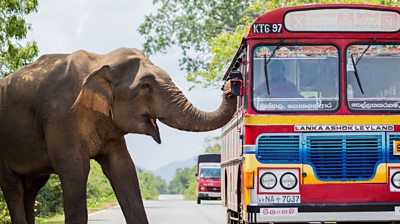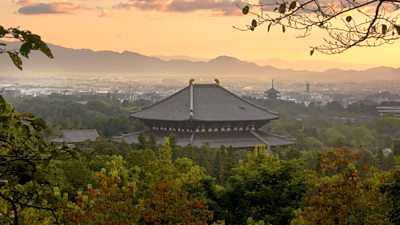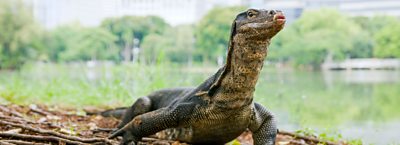Asia, the most densely-populated continent of all, is home to almost five billion people. This is more than the rest of the world combined. Yet, human settlements offer unique opportunities for those animals that are bold enough to seek them.
During festivals, the city of Bhopal, in central India, fills with light. In the shadows a tigress is on the prowl, lured by the chance to hunt cattle. She has learnt to be invisible, using the same routes as people, but never at the same time. And she’s doing so well, she has a litter of four cubs.
Urban tigers have learnt to thrive in the human world by staying out of the spotlight. In Sri Lanka Asian elephants take a very different approach. They pick up meals at the roadside by stopping traffic. Using their four-tonne bodies as roadblocks, buses can’t get past until a toll, in the form of food, is paid. It’s a price that most people are more than willing to pay.
Such tolerance exists amongst people right across Asia. In Nara, Japan, Sika deer are free to roam anywhere they please in this city. In autumn males fight for dominance. To avoid accidents, their antlers are removed. But when a local male encounters an out-of-towner whose antlers are intact, he nevertheless challenges him to a fight. Remarkably, despite his lack of ‘weaponry’, the local deer emerges victorious.
In India, in the foothills of the Himalaya, the millet crop is ready for harvesting. But a raid is being planned by a troop of Himalayan langurs. The village dogs pose a real threat, but the langurs are smart – the fastest and bravest males lure the dogs away, allowing the more vulnerable langurs to escape with their lives.

Agriculture in India has shaped the landscape for thousands of years. In drainage ditches in Gujurat, checkered keelback snakes gather once a year waiting for migrating fish to pass through a narrow culvert. When they do, a feeding frenzy is triggered.
Across Asia, people are building in all directions faster than anywhere else on Earth. In just a few decades Singapore has become totally urban and it is still expanding. Today, two-thirds of the world’s mega-cities are in Asia.
In Taipei, the capital of Taiwan, a giant flying squirrel has made its home in a school. Every night he must cross the metropolis to get to his feeding grounds on the edge of the city. With every flight he loses altitude which must be regained through climbing – the city streets are dangerous places and he cannot afford to land there.
Another Taipei resident manages to find all it needs without having to commute – the rhinoceros beetle. Males gather in large numbers on ash trees where they fight for mating rights.
Bangkok, the capital of Thailand, has a population of ten million. Yet giant water monitor lizards are thriving in a park in the city centre. Males dominate and they catch fish and even pigeons. One plucky female must barge into the midst of brawling males to grab some food for herself, wielding her huge tail as a whip to slap away rivals.
A few animals undoubtedly do well amongst humans, but most species need a more natural world. In Borneo, in just fifty years, the human population has tripled. And the size of its forest has halved. Proboscis monkeys are running out of habitat and increasingly have to live a life on the move seeking out dwindling patches of forest.
One species though has become dependent on people – swifts. In the Middle East, they make their homes in ancient buildings, in cracks between the stones. If they can, they return to the same nest site each year. But the urban world on which they have relied is changing as modern tower blocks replace older dwellings with no nooks and crannies.
- Watch all episodes of Asia on �鶹�� iPlayer and add to your Watchlist now
- Watch Asia, episode four on �鶹�� One from Sunday 1 December at 6.20pm
FS
Filming locations

- Episode intro: Kim Noi, Hanoi, Hoi Chi Minh City, Vietnam
- Urban tiger: Bhopal city, India
- Elephants on the road: Buttala-Kataragama Roa, Sri Lanka
- Urban deer: Nara, Japan
- Himalayan langurs: Siroli village, Uttarakhand, India
- Snakes and fish: Gujarat, India
- Urban growth: Singapore and Tokyo, Japan
- Giant flying squirrel: Taipei, Taiwan
- Rhinoceros beetles: Taipei, Taiwan
- Urban water monitor lizard: Bangkok, Thailand
- Proboscis monkeys: Balikpapan, Indonesia
- Swifts: Jerusalem, Israel
Interesting facts

- The sequence of the Royal Bengal tiger was filmed using a series of 22 remote cameras that were in position for five months.
- Sri Lanka has the highest density of Asian elephants in the world. Sri Lankan elephants spend 18-20 hours a day eating and they only sleep for four hours a day.
- Red giant flying squirrels can glide for over 150m.
- Swifts spend almost all of their lives on the wing – they can spend up to ten months of the year in the air, never touching land – a world record for sustained flight in nature. They eat, sleep, drink and even mate on the wing. In a single swift’s lifetime it may fly some four million miles and they can fly 500 miles per day (that’s London to Berlin).
Filming feats
- Most tigers in the wild have around two cubs at a time. The team managed to film a female that had four healthy cubs from one pregnancy – a fantastic sign that she is healthy and thriving.
- As far as we are aware the feeding frenzy of the checkered keelback has never been filmed for broadcast before.
Technology and behind the scenes

- To capture the amazing fish hunting behaviour of the checkered keelbacks, the team used a specialist slow-motion camera that shoots almost 1,000 frames per second. This allows the audience to see the snake strikes in detail, but makes for difficult filming. Slow motion cameras require a lot of light, which can have an adverse effect on the snakes’ behaviour. Striking the balance between lighting the action properly and not scaring the snakes away was a tricky balance.
- To film the amazing Rhino beetle courtship fights up close, the team used a special macro lens called a Laowa probe. This enabled them to get intimate shots from the beetle’s perspective, immersing the audience in their world.
